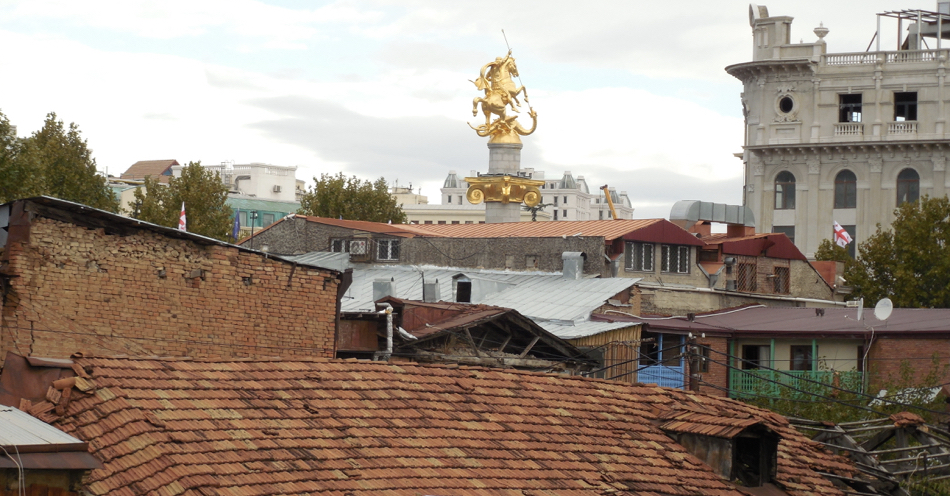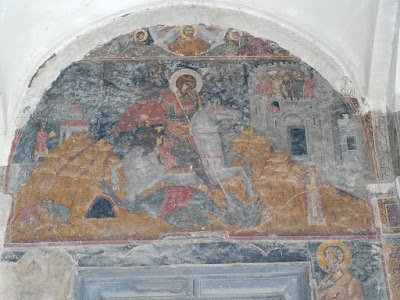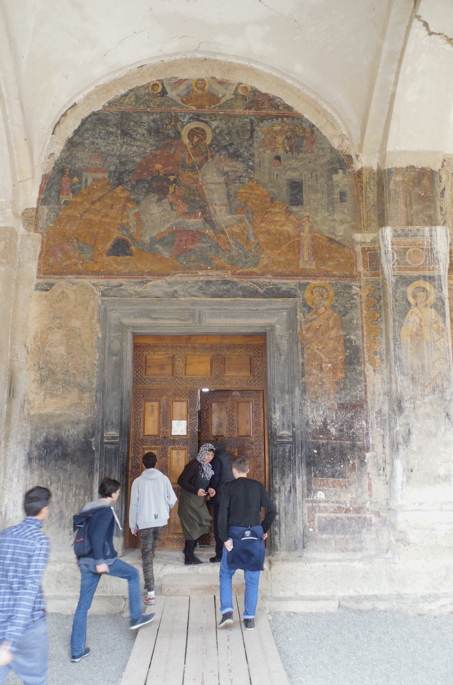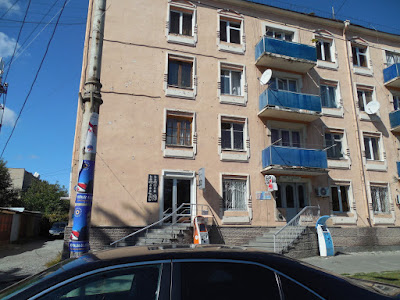Defeating Dragons In Georgia
As our host drives us from the Tblisi airport to our Airbnb apartment near the center of Tblisi, he points out the window. “Your apartment is near the central square, so if you get lost, just ask where the square is, and you’ll be able to find your way home.” Out the window is the square, marked by a column so tall that we can’t see the top out of the car window.

So when we get to our apartment we step onto the rooftop patio to get a look at the column, and this time we get to see the column's top: a bright, new, gold-plated statue of St. George killing the dragon.


It doesn’t take us long to find images of St. George and the dragon everywhere. There are stuffed toy St. Georges for kids. We pass a government building on the way to the city center, and find St. George on a government emblem.

We stop for a snack, and the clerk gives us a coin with St. George on the heraldic banner in the center. Clearly, the image of St. George is an important national symbol in Georgia!

But it’s more than just a national symbol.
Driving out of town, we stop at the Alaverdi Monastery. Above the door to the church is - you guessed it - an image of St. George. It’s the first of several times we see the image associated with a church. So it’s also an important Christian symbol.


Our guide explains that the image of a horseman killing a dragon dates back to pre-Christian times. The pagan image of the horse came in three colors: red, black, and white.
-
The red horse rode on the earth.
-
The white horse rode to heaven.
-
The black horse rode to hell.
In each case, red, black, or white, Christian or pagan, it is an image of the defeat of evil. And in case you were wondering, there was no real St. George. He's only a legend.
So one wonders, why is the image so important, so prominent in Georgian culture? First of all, you must realize that Georgia has been, since the 10th Century BC, a cross-roads nation. The silk road crossed Georgia. Oil from Asia crosses Georgia today. and with the coming and going of all these merchants, there has always been a danger of invasions. And the danger remains to this day.
Our guide is eager to point out who/what the current invading “dragon” is.
As we drive to Gori, he points out the huge settlements of people who have been driven from their homes when Russia moved in to occupy two regions of the Georgia (Russian occupied regions are shown in stripes on the map.). We stop at a factory, and next to our car is a cluster of tourists talking and laughing loudly. “Russians,” says our guide, frowning. As we enter Gori, he points to the bullet-riddled walls lining the street. "Russians," he says again.

But the image of St. George persists, and the hope remains: dragons will be defeated.
If you like learning more about fantastic creatures, get one of these art lessons for kids today:
As our host drives us from the Tblisi airport to our Airbnb apartment near the center of Tblisi, he points out the window. “Your apartment is near the central square, so if you get lost, just ask where the square is, and you’ll be able to find your way home.” Out the window is the square, marked by a column so tall that we can’t see the top out of the car window.

So when we get to our apartment we step onto the rooftop patio to get a look at the column, and this time we get to see the column's top: a bright, new, gold-plated statue of St. George killing the dragon.


It doesn’t take us long to find images of St. George and the dragon everywhere. There are stuffed toy St. Georges for kids. We pass a government building on the way to the city center, and find St. George on a government emblem.

We stop for a snack, and the clerk gives us a coin with St. George on the heraldic banner in the center. Clearly, the image of St. George is an important national symbol in Georgia!

But it’s more than just a national symbol.
Driving out of town, we stop at the Alaverdi Monastery. Above the door to the church is - you guessed it - an image of St. George. It’s the first of several times we see the image associated with a church. So it’s also an important Christian symbol.


Our guide explains that the image of a horseman killing a dragon dates back to pre-Christian times. The pagan image of the horse came in three colors: red, black, and white.
-
The red horse rode on the earth.
-
The white horse rode to heaven.
-
The black horse rode to hell.
In each case, red, black, or white, Christian or pagan, it is an image of the defeat of evil. And in case you were wondering, there was no real St. George. He's only a legend.
So one wonders, why is the image so important, so prominent in Georgian culture? First of all, you must realize that Georgia has been, since the 10th Century BC, a cross-roads nation. The silk road crossed Georgia. Oil from Asia crosses Georgia today. and with the coming and going of all these merchants, there has always been a danger of invasions. And the danger remains to this day.
Our guide is eager to point out who/what the current invading “dragon” is.
As we drive to Gori, he points out the huge settlements of people who have been driven from their homes when Russia moved in to occupy two regions of the Georgia (Russian occupied regions are shown in stripes on the map.). We stop at a factory, and next to our car is a cluster of tourists talking and laughing loudly. “Russians,” says our guide, frowning. As we enter Gori, he points to the bullet-riddled walls lining the street. "Russians," he says again.

But the image of St. George persists, and the hope remains: dragons will be defeated.
If you like learning more about fantastic creatures, get one of these art lessons for kids today:
As our host drives us from the Tblisi airport to our Airbnb apartment near the center of Tblisi, he points out the window. “Your apartment is near the central square, so if you get lost, just ask where the square is, and you’ll be able to find your way home.” Out the window is the square, marked by a column so tall that we can’t see the top out of the car window.

So when we get to our apartment we step onto the rooftop patio to get a look at the column, and this time we get to see the column's top: a bright, new, gold-plated statue of St. George killing the dragon.


It doesn’t take us long to find images of St. George and the dragon everywhere. There are stuffed toy St. Georges for kids. We pass a government building on the way to the city center, and find St. George on a government emblem.

We stop for a snack, and the clerk gives us a coin with St. George on the heraldic banner in the center. Clearly, the image of St. George is an important national symbol in Georgia!

But it’s more than just a national symbol.
Driving out of town, we stop at the Alaverdi Monastery. Above the door to the church is - you guessed it - an image of St. George. It’s the first of several times we see the image associated with a church. So it’s also an important Christian symbol.


Our guide explains that the image of a horseman killing a dragon dates back to pre-Christian times. The pagan image of the horse came in three colors: red, black, and white.
-
The red horse rode on the earth.
-
The white horse rode to heaven.
-
The black horse rode to hell.
In each case, red, black, or white, Christian or pagan, it is an image of the defeat of evil. And in case you were wondering, there was no real St. George. He's only a legend.
So one wonders, why is the image so important, so prominent in Georgian culture? First of all, you must realize that Georgia has been, since the 10th Century BC, a cross-roads nation. The silk road crossed Georgia. Oil from Asia crosses Georgia today. and with the coming and going of all these merchants, there has always been a danger of invasions. And the danger remains to this day.
Our guide is eager to point out who/what the current invading “dragon” is.
As we drive to Gori, he points out the huge settlements of people who have been driven from their homes when Russia moved in to occupy two regions of the Georgia (Russian occupied regions are shown in stripes on the map.). We stop at a factory, and next to our car is a cluster of tourists talking and laughing loudly. “Russians,” says our guide, frowning. As we enter Gori, he points to the bullet-riddled walls lining the street. "Russians," he says again.

But the image of St. George persists, and the hope remains: dragons will be defeated.
If you like learning more about fantastic creatures, get one of these art lessons for kids today:








